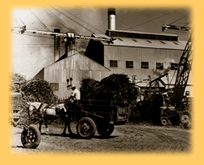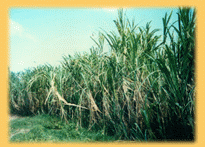





 |
Sugar cane came to Louisiana as early as 1733 when the Jesuit priests brought cane stalks from Santo Domingo. It was used primarily as chewable stalks and as a confection similar to molasses. Sixty-one years later (1794), a fellow by the name of Etienne de Bore opened the first successful sugar mill on the site where Audubon Park is located today. It was at that time the method of creating granulated sugar was put into production and started the industrial sugar revolution. Two hundred years later, Roland F. LeBlanc, Jr. of Abbeville, Louisiana conceived the idea of turning the juice of sugar cane into jelly. Driven by, ingenuity and the grace of God, along with the legacy of past generations (Roland's grandfather was Senator Dudley J. LeBlanc, Sr., otherwise know as "Coozin Dud: the inventor and promoter of Hadacol, the cure-all elixir). Roland F. LeBlanc, Jr. set out to develop a new product. After three years of experiments research, and travel, he with a handful of shareholders under the corporate name "The LeBlanc Jelly Co." successfully opened the first Cane Jelly™ manufacturing facility. |
|
 |
The Southern Region of Louisiana is rich with an abundance of sugar cane. In the fall, the stalks stand 7' to 10' tall and grow 1" to 1-1/2" in diameter, it is cut and transported to mills where it is piled in great heaps awaiting the grinding process. After grinding the stalks, the juice is converted by open kettle cooking, a filtering and centrifuge process, into what we know as syrup, molasses and raw cane crystals. It is at this point that these co-products, having the highest flavor and mineral content before being refining are used to manufacture our jellies. Most commercial and homemade jellies contain some or all of the following ingredients, artificial flavor, food coloring, and refined sugars, corn syrup, high fructose corn syrups, stripped of nutrients and minerals. Health studies have found these ingredients to be harder for the body digest. The LeBlanc Jelly Company uses a different process in manufacturing Cane Jelly™. This insures the authentic flavor and wholesomeness extracted from sugarcane to be present in each jar. Our all natural sweetener is the flavor, nothing artificial, easy for the body to digest. "These are not your ordinary Jellies," as a stand alone condiment the aroma and flavor is outstanding. The standard for Jelly has been elevated through the many benefits Cane Jelly™ delivers .The properties brought out in Cane Jelly™ are exceptional when employed in cooking. They are used widely as a meat tenderizer, marinate, and seasoning. When employed as a seasoning, the properties in Cane Jelly™ enhance the subtle flavors which are unnoticed in seafood, wild game, meats and vegetables. They are surprisingly brought to light when cane jelly is rubbed on. Your selection of meat will brown quicker with less heat. The jelly caramelizes acting as a bag sealing in moisture. This results in your choice of meat being juicer as the properties in cane enhance subtle flavors. Injecting Cane Jelly™ in domestic or wild game as a tenderizer or marinate, expands your success in fine dining at home. Cane Jelly™ is perfect for: * a glaze, * creating a dark Cajun gravy*, in a roux for a gumbo or stew, * broiling fish, chicken, or chops. The ease of cooking combined with these magnificent flavor guarantee's fine dining prepared in your own kitchen. Yes, Cane Jelly™ is used in the conventional way jellies have been thought upon. The value added in each jar is realized when first opened. The aroma screams Cajun Louisiana. A little spread on a hot buttered biscuit goes a long way in taste. This allows a moderate portion for each serving. Now that's quality! Thank you for visiting our website. We hope that you will enjoy this authentic Cajun product that we know and love in South Louisiana.
|
|
Letter |
||
 |
Dear Friend, There are many notable characteristics of Cajun people including faith, language, family, music, love for the outdoors, and hospitality but especially cooking. It's all about Food. Over the years, Cajun cuisine has become increasingly popular around the country and the world. Being raised in a small Cajun community, our ancestors were very meticulous in the culinary art. Taste, being paramount and strictly scrutinized. It became a part of our normal upbringing. We hope you will consider visiting South Louisiana one day, but until then, it would be our pleasure to serve you a bit of our culinary heritage. We are confident that you will enjoy the unique flavor that Cane Jelly™ brings to your table. Thank you for shopping with us. R. F. LeBlanc, Jr.
|
|
|
IN
THE NEWS
|
||
|
|
Creative Cane Sugar cane jellies created unique culinary enterprise Story by Judy Stanford Sugar cane is a familiar part of life in this area. We see evidence of it daily in the fields of cane lining the highways to the cane syrup lining the supermarket shelves. Now an Abbeville man has come up with a new twist. Roland LeBlanc has developed a cane jelly. "Having an insurance agency," LeBlanc said, "I was visiting with a client who happened to be a cane farmer. He was complaining that there had been no new product from sugar cane in 200 years. He sang that sour song all evening and it made an impression on me. Driving home, was divine inspiration - why not make jelly?" LeBlanc began to work on the idea, but it wasn't as easy as it sounded. "My anticipation was this will be a snap. There can't be anything to it. Next week we should have a product." But it took three years of research, the later back and forth to the Food Science Lab at LSU. LeBlanc's product is now patent pending, is sold throughout South Louisiana, the Gulf of Mexico, and the World Wide Web. There are a number of recipes using Cane Jelly™. Dark Cane Jelly™ and Lite Cane Jelly™ are perfect for recipes like Cajun Cane Cake, Quick Cane Dessert or Cane Lime Pie. Pepper Cane Jelly™ works well for entrees', like Co chon de Cane, a pork loin dish, or Cane grilled shrimp. Barbecue Cane Jelly™ gives his Barbecue Cane Glazed Duck a slightly sweet flavor. Although LeBlanc has worked in the insurance business, he briefly worked as a chef in his younger days. But that's not how he learned, he said. "It's in the blood. My grandfather enjoyed elaborate meals regularly. Having an occasional seat at his table, one acquired a taste for fine food." LeBlanc said he learned to cook from his grandmother and his mother. "I would sit on the counter and watch them cook." Tragically, his mother became ill and he continued his interest in cooking with their housekeeper. I'd taste the dish and ask what was in it, but she was reluctant to answer. "It was always a challenge to figure it out." "With mother ill and the daily chore of preparing meals for a family of nine, their was plenty of opportunity to exercise one's passion for cooking." |
|

